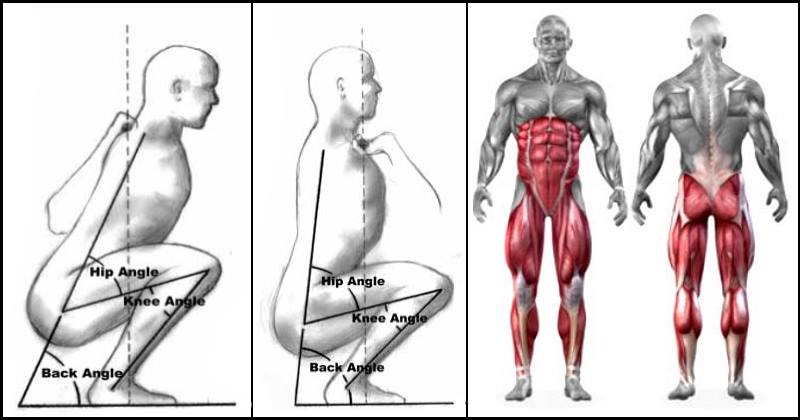It’s almost universally agreed upon that the number one exercise for getting huge quads, hamstrings and a*s is the squat! Regardless of your goals when training legs, whether it be for mass or strength, squats will always be the most effective exercise you can incorporate into your training regimen. There are many squat variations which can be done with various types of resistance whether in the form of body weight, resistance bands, heavy dumbbells or barbells loaded with an adequate load.
For anyone who is serious about getting the most out of their leg training, the two most popular squat variations are the classic barbell back squat and the front squat.
In the fitness and strength training world, the squat is a full body, compound exercise that targets multiple muscle groups especially the hips, thighs and buttocks, i.e. the quads, hamstrings and it also helps in strengthening the bones, ligaments and tendons’ insertions in the lower body.
Almost unanimously, squats are considered to be an essential movement for increasing the size and strength of the legs and buttocks, while also increasing core strength. When the squat is performed with a proper form, besides the primary muscles the lower and upper back, the abs, trunk muscles, intercostal muscles, arms, and shoulders are all trained isometrically.
However, there’s been a fiery debate going on for a few years now about which squat variation is better. Is it the back squat or the front squat?
The standard barbell back squat is a natural squatting movement which allows more load to be put on the barbell, leading to greater long-term muscle gain. The front squat, however, is the less popular version, so a lot of people are quite unaccustomed to doing them and you may not be able to load the barbell with too much weight as you would with back squats.
When you place the barbell in front of your body, you change the biomechanics, thus providing stimulus to slightly different muscles.
First, let’s delve into the specifics of the back squat, and then the front squat:
The way you execute a back squat is by unracking the barbell loaded with weights, resting it across your upper back and shoulders, standing with the feet should-width apart and squeezing it tight with both of your hands. Shift the weight into the heels and start squatting until the top of the thigh is just below the top of the knee.
Drive the heels into the floor and extend the legs upwards until you get back into the starting standing position. Keep the core tight at all times and the spine straight during the entire movement.
The barbell back squat is the most effective full-body compound mass-building movement. You get to train your quads, hamstrings, glutes, erector spinae, soleus, gastrocnemius, adductor and abs all with one movement. Back squat can be done with lighter loads for muscle definition and toning or with heavier loads for both bodybuilding, power building, and powerlifting goals. No matter what your individual goal is, back squats are considered by many in the fitness world to be the quintessential exercise for legs.
The front squat is a movement that is best performed inside a squat rack for safety reasons. Before you start the movement, place the bar on the level that matches your height the best. Once you’ve done this and you’ve loaded the bar, bring the arms under the bar while getting your elbows to point upwards at all times and get your upper arm in a slightly above parallel position to the floor. Then, rest the bar on the top of your shoulders and cross the arms whilst grasping the bar to control it better.
Lift it off the squat rack by pushing with the legs first while straightening the torso. Take one to two steps away from the rack and put your feet shoulder-width apart with your toes pointed slightly out. Always keep the head up because if you look down you will get off balance and don’t forget to keep your back straight. This will be the starting position.
Start lowering the bar slowly by bending your knees while maintaining a straight back with your head pointed upwards. Continue squatting until the upper leg-calf angle becomes slightly less than ninety degrees, which is the angle in which the upper legs are slightly below parallel to the floor. When you do this part of the movement, inhale. Begin raising the bar and start exhaling by imagining that you push the floor with the middle of the foot, while you straighten your legs again and get back to the starting position. Repeat for as many repetitions as your training program says.
Even though front squats do not stimulate the gluteus muscles and the hamstrings as efficiently as back squats, they tend to have a greater impact on the three quadriceps heads. This is why a lot of strength athletes do front squats as an assistance movement.
Another benefit that the front squat provides is that, because the barbell is supported in front of your head, the torso is in a more vertical position, which lessens the burden on your lower back. However, many athletes have complained that supporting the barbell on the front of their shoulders was extremely uncomfortable and sometimes outright painful.
So what’s the conclusion? Which one’s better? Back or front squats? The simple answer is that they are both good. Use the back squat when you want to build overall leg muscle mass. But if you need to put an emphasis on the quads, incorporate the front squat as well. It would be best if you started with back squats and then proceed to do a few sets of front squats. If have knee problems preventing you doing back squats, then do some front squats.



